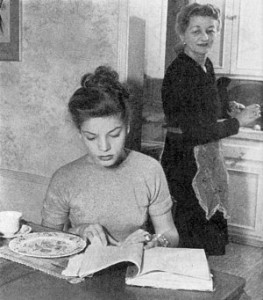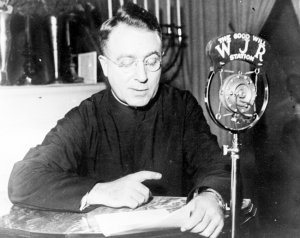Ken Waltzer inadvertantly supplies proof that Elie Wiesel was not at Buchenwald
Sunday, September 8th, 2013
By Carolyn Yeager
Above: Ken Waltzer’s now notorious signature photo connecting him to his claim, for years, that Elie Wiesel was in this photograph of youths from the Buchenwald children’s barracks being marched out of the camp after so-called liberation.
We have further proof that Elie Wiesel was not at Buchenwald because Prof. Ken Waltzer is still unwilling to publish his book about the “rescue of children from Buchenwald,” a book which has always included the “Nobel Laureate Elie Wiesel”among the children.
Since Waltzer is the only holocaust “historian” I know who is still on record as saying he can prove that Elie Wiesel was a prisoner at the Buchenwald concentration camp—and that his father Shlomo died there—I think that makes Waltzer a fitting subject for this website. And the 84-year old Wiesel himself is not doing anything that I can find news of these days, so I’m a little hard up for inspiration.
Thus I ask: What is Waltzer up to? Well, he has been heading a group of Michigan Jews in creating a traveling exhibition that is meant to remind Jews, and convince if necessary, of all the poisecution they experienced during the WWII years and to celebrate how extraordinarily well things have been going for Jews since (while, of course, still having to be on guard against new poisecution).
Thus, the exhibition is titled Uneasy Years: Michigan Jewry During Depression and War. Michigan Jewry! How many Jews are in Michigan? According to a Jewish website, in 2012 there were 82,270, which is 0.8% (8/10 of 1%) of the total Michigan population. But that is enough for Ken Waltzer and other Jews to build an entire traveling exhibition for.
Or could the reason really be that Waltzer, as a professor at Michigan State University, must always show that he is active and contributing scholastically in his area of expertise. Since his book on the “rescue of children at Buchenwald” continues to be in a state of “research”—after all these years—he must find other projects to work on. 1 Last year he was consultant on a Jewish film project about holocaust survivors. This year he’s got the traveling exhibition.
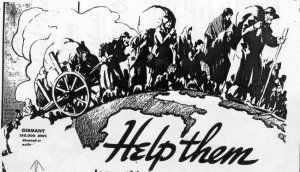 What is learned from the exhibition
What is learned from the exhibition
The 21st Century Jews of Michigan are told that in past times they had to join together to help needy fellow Jews. The message is conveyed that they still need to do so because Jews are always in need, as “anti-Semitism” is always a threat—somewhere. Hasn’t it always been so? Elie Wiesel would approve of this message! [Right: Theme image for the Allied Jewish Campaign, 1938]
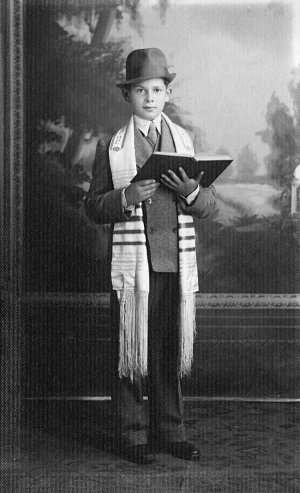 The main thing I notice about this exhibit is that it is totally, 100% about Jews and specifically Jewish concerns. The few non-Jews mentioned are enemies of the Jews. While it starts out saying that by the 1930’s Jews were increasingly comfortable with American ways, it shows nothing about Jews integrating socially with American gentiles and Christians, but only sticking closely with their own kind, their own organizations, their synagogues and businesses. Jews want to be accepted by the majority Gentile culture as “just like them,” but they do not want to participate in the majority Gentile culture, except politically and financially. [Left: Bar Mitzveh Day for Harry Klein]
The main thing I notice about this exhibit is that it is totally, 100% about Jews and specifically Jewish concerns. The few non-Jews mentioned are enemies of the Jews. While it starts out saying that by the 1930’s Jews were increasingly comfortable with American ways, it shows nothing about Jews integrating socially with American gentiles and Christians, but only sticking closely with their own kind, their own organizations, their synagogues and businesses. Jews want to be accepted by the majority Gentile culture as “just like them,” but they do not want to participate in the majority Gentile culture, except politically and financially. [Left: Bar Mitzveh Day for Harry Klein]
It tells us that Michigan Jews were terribly affected by the war in Europe—the spread of Nazism in Europe brought rising “anti-Semitism” in the U.S, and Michigan was not spared! Evil people like Catholic priest Father Charles Coughlin were openly “anti-Semitic” and 30 million non-Jewish Americans listened to his weekly radio broadcasts. [Shown at right speaking over WJR radio in the 1930s] The exhibit particularly excoriates Father Coughlin simply because he warned about excessive power of the Jews. The exhibit shows that Life and Time magazines, and the powerful Detroit Free Press were all on the side of the Jews against Father Coughlin … so where was the problem? Are we dealing with a real threat or with some kind of Jewish agenda here?
At the same time, Jews like Lauren Bacall [at left as a young woman at home – look at the nose on Mom! Was Lauren given a nose job?] and baseball player Hank Greenberg were given great, positive media attention.
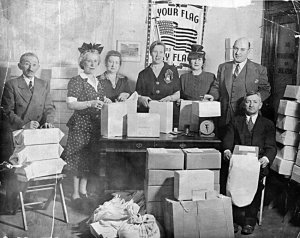 The exhibit tells how the Jews of Michigan supported the war. America’s participation was a wonderful thing. Helping the European Jews was what we should all be doing. Jews like young Harriet Fields collected 381,000 pounds of household waste fat! The Federation of Polish Jews in Detroit [shown right, publicizing their war service] sent packages to the men and women of the Armed Services. The Jewish-owned Paramount Coffee Company of Lansing sent out New Year’s Greeting flyers about the importance of helping one another (without mentioning the war at all, though). The Temple Beth El Bulletin encouraged people to buy war bonds!
The exhibit tells how the Jews of Michigan supported the war. America’s participation was a wonderful thing. Helping the European Jews was what we should all be doing. Jews like young Harriet Fields collected 381,000 pounds of household waste fat! The Federation of Polish Jews in Detroit [shown right, publicizing their war service] sent packages to the men and women of the Armed Services. The Jewish-owned Paramount Coffee Company of Lansing sent out New Year’s Greeting flyers about the importance of helping one another (without mentioning the war at all, though). The Temple Beth El Bulletin encouraged people to buy war bonds!
Jewish organizations made sure they offered social and spiritual support for specifically Jewish soldiers. Beginning in 1942, Jews began protesting a “Nazi Holocaust” of European Jews in Detroit newspapers and in public meetings. The exhibit shows pictures of two whole Michigan Jews who had fallen … they are portrayed as heroes. And it doesn’t leave out that America did not want to take in all of Europe’s Jewish refugees who wanted to come here. It points out everything that the Jews did to help other Jews, and how they got non-Jews to help Jews too.
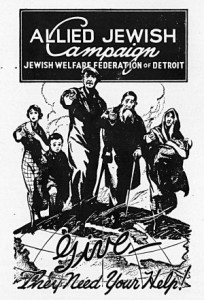 The Allied Jewish Campaign raised money to help Jews. Wow, what sacrifice! “Between 1932 and 1940, its theme shifted from taking care of the needy Jews in the United States to supporting rescue and survival of Jews abroad.” It’s fundraising goal rose from $165,000 to $925,000. Guess who they got most of the money from?
The Allied Jewish Campaign raised money to help Jews. Wow, what sacrifice! “Between 1932 and 1940, its theme shifted from taking care of the needy Jews in the United States to supporting rescue and survival of Jews abroad.” It’s fundraising goal rose from $165,000 to $925,000. Guess who they got most of the money from?
And, of course, “Michigan Jews, especially in Detroit, were active on behalf of building a Jewish homeland in Palestine.” Finally, the stories of four Jewish children who came to the U.S as refugees and are such treasures. Then, MSU’s Jeanette Abeles , Ken Waltzer and Michael Seadle tell stories, with pictures, of their Jewish family history, though none were connected with Michigan. Have we heard enough about Jews yet?
From whence the money comes
This traveling exhibition was made possible with financial support from Congregation Shaarey Zedek of East Lansing, Michigan State University Jewish Studies Program (that’s Waltzer’s domain), Michigan State University Museum, the Michigan Humanities Council, the Ben Teitle Foundation, the Michigan Council for Arts and Cultural Affairs and private donors.
For a fee of $800, plus shipping, the exhibition has been displayed at the following sites so far (according to the website): Northern Michigan University, Marquette, MI; Macomb Community College, Clinton Twp, MI; and Kalamazoo Valley Museum, Kalamazoo, MI.
This “anti-anti-Semitism” project extolling the virtues of Jews is what Ken Waltzer has kept himself busy with in 2013, instead of finishing his book on the children of Buchenwald. What will he come up with next? It’s been clear for some time that the main guiding force for Waltzer is the promotion of Jewry, in whatever way best achieves that goal. Holocaustianity is certainly one way. Heading a Jewish Studies program at a university is another. Working in conjunction with the U.S. Holocaust Memorial Museum is another. And certainly, protecting and promoting the image of Elie Wiesel is also one.
It’s possible, however, that he’s run into a brick wall on Elie Wiesel.
Endnotes:
1. Waltzer admittedly relies on survivor testimony – the least dependable form of “evidence.” In this 2011-2012 Q-A session linked to above, he says:
… my own book, Telling the Story: The Rescue of Children at Buchenwald, will be finished in about a year and will tell the story in much greater detail and more attention to complexity, drawing on information obtained from nearly 200 of those who were helped to survive at the Nazi camp. It will say more about who these boys were, what their experiences were both before Buchenwald and then inside Buchenwald, and where they went and what they did with their memory of experience after liberation. A second book, to be prepared thereafter, will be called Children’s Stories, and will pull together many distinctive stories I’ve been told or have encountered while working on the collective story.
Note that Waltzer is “telling a story” that has been told to him by old men about what happened to them as children. Realize what “story” means to Jews – one is freed from all necessity of accurate fact.
Category Featured | Tags: Tags: Allied Jewish Campaign, anti-Semitism, Charles Coughlin, Hank Greenberg, Jeanette Abeles, Jewish homeland in Palestine, Ken Waltzer, Lauren Bacall, Michael Seadle, Michigan State University,
Social Networks: Facebook, Twitter, Google Bookmarks, del.icio.us, StumbleUpon, Digg, Reddit, Posterous.


